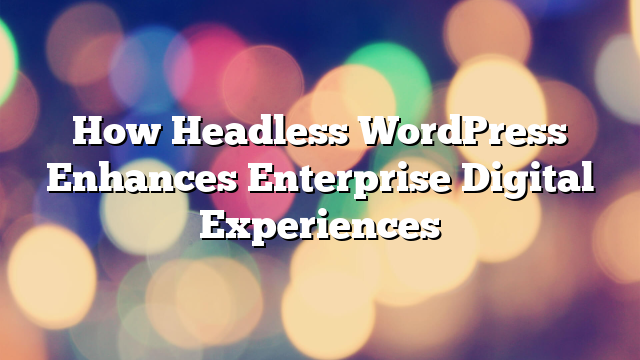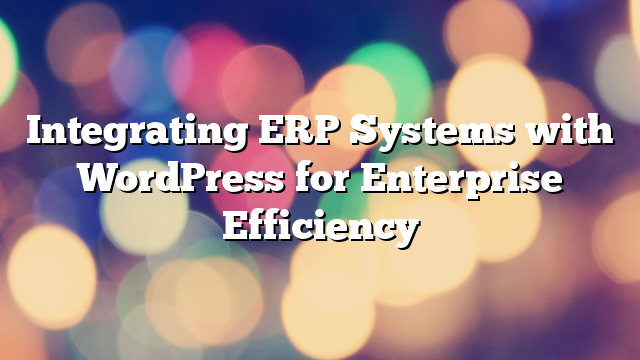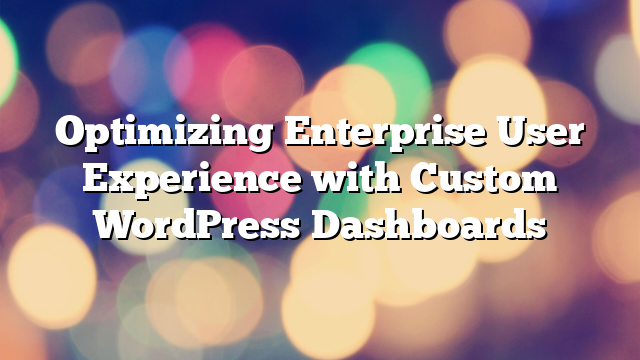How Headless WordPress Enhances Enterprise Digital Experiences
31.10.2024

Headless WordPress has become a popular solution for enterprises looking to deliver cutting-edge digital experiences. By decoupling the front-end from the back-end, Headless WordPress allows businesses to create highly dynamic, omnichannel digital experiences while still leveraging the powerful content management capabilities of WordPress. In this article, we’ll explore how Headless WordPress can enhance enterprise digital experiences and why it’s the future of content management.
What is Headless WordPress?
In a traditional WordPress setup, the front-end (what users see) and the back-end (where content is managed) are tightly integrated. The back-end handles both the content management and the display of that content on the front-end, using WordPress’ built-in themes and templates.
In contrast, Headless WordPress separates the two. With Headless WordPress, the back-end still handles content management, but the front-end can be built using any technology, such as React, Vue.js, or Angular. Content is delivered to the front-end via APIs, usually through the WordPress REST API or GraphQL, allowing businesses to create more dynamic, fast, and interactive user experiences.
The Benefits of Headless WordPress for Enterprises
Headless WordPress offers a range of benefits that make it particularly well-suited for enterprise-level content management and digital experience creation:
1. Flexibility in Front-End Development
One of the key advantages of Headless WordPress is the freedom to use any front-end technology. Enterprises are no longer limited to WordPress themes and templates for presenting content. Instead, they can use modern JavaScript frameworks like Next.js, React, Vue.js, or Angular to build highly customized, interactive, and fast user interfaces.
This flexibility allows enterprises to create unique digital experiences that align with their brand identity and meet the specific needs of their audience. Developers can implement custom designs, animations, and features that would be difficult or impossible to achieve using traditional WordPress themes.
2. Omnichannel Content Delivery
In the age of digital transformation, enterprises need to deliver content across multiple platforms and devices, including websites, mobile apps, voice assistants, smart TVs, and more. Headless WordPress enables omnichannel content delivery by separating the content repository (WordPress) from the presentation layer. Content is stored in the back-end and can be delivered to any device or platform via APIs.
This is especially useful for enterprises that want to maintain a consistent user experience across different touchpoints. Whether customers are accessing content through a website, mobile app, or IoT device, Headless WordPress ensures that content is delivered seamlessly across all channels.
3. Enhanced Performance and Scalability
Performance is a critical factor for enterprises, particularly those with high traffic websites or global audiences. Traditional WordPress sites can become slow and difficult to scale as they rely on server-side rendering and heavy PHP processing. Headless WordPress, on the other hand, allows for faster and more scalable architectures by leveraging modern front-end frameworks and static site generation (SSG).
With Headless WordPress, the front-end can be optimized for performance using technologies like server-side rendering (SSR) or static site generators (SSG) such as Next.js or Gatsby. These technologies reduce load times and improve the overall user experience by pre-rendering pages and delivering static content, making Headless WordPress an ideal solution for enterprises that need to serve content quickly to global audiences.
4. Improved Security
By decoupling the front-end and back-end, Headless WordPress provides an additional layer of security for enterprise websites. Since the content management system is hidden behind APIs, it becomes more difficult for attackers to exploit vulnerabilities in the WordPress back-end. The front-end is completely separated from the WordPress core, reducing the risk of common attacks such as SQL injection or cross-site scripting (XSS).
Enterprises can also implement additional security measures, such as custom authentication mechanisms, firewalls, and secure API connections, to further protect their data and content.
How Headless WordPress Supports Enterprise Growth
For enterprises, scalability and flexibility are essential for long-term growth. Headless WordPress supports enterprise growth in several ways:
1. Faster Development Cycles
With Headless WordPress, development teams can work more efficiently by decoupling the front-end and back-end. Developers can focus on building the front-end without worrying about the constraints of the WordPress theme structure, while content creators can continue managing content in the familiar WordPress back-end. This separation of concerns speeds up the development process and allows teams to launch new features and digital experiences faster.
2. Future-Proofing Your Digital Strategy
As technology continues to evolve, enterprises need a content management system that can adapt to new platforms and devices. Headless WordPress future-proofs your digital strategy by enabling omnichannel content delivery and supporting new front-end technologies as they emerge. Whether your business needs to build a progressive web app (PWA), integrate with voice search platforms, or launch content on new devices, Headless WordPress ensures that your content is ready to meet the challenges of tomorrow.
3. Internationalization and Localization
Enterprises that operate in multiple regions or serve diverse audiences need to deliver localized content in different languages and formats. Headless WordPress makes it easy to manage internationalization and localization efforts by centralizing content in the back-end while allowing the front-end to handle language-specific or region-specific user experiences.
This is particularly useful for businesses with global operations, as they can maintain a consistent brand identity while adapting their content for local markets. The flexibility of Headless WordPress ensures that enterprises can scale their digital presence without being limited by traditional WordPress architectures.
Integrating Headless WordPress with Enterprise Systems
Another significant advantage of Headless WordPress is its ability to integrate seamlessly with other enterprise systems, such as customer relationship management (CRM) platforms, marketing automation tools, and analytics solutions. Through APIs, Headless WordPress can connect with these systems, enabling businesses to create a unified digital ecosystem that supports their marketing, sales, and customer engagement efforts.
For example, enterprises can use Headless WordPress to deliver personalized content to users based on data from their CRM or marketing platforms. By integrating with tools like Salesforce, HubSpot, or Marketo, businesses can leverage customer insights to deliver tailored content and improve user engagement.
Challenges of Headless WordPress for Enterprises
While Headless WordPress offers numerous advantages, there are also challenges that enterprises should consider:
- Increased Complexity: Implementing a Headless WordPress architecture requires more technical expertise than a traditional WordPress setup. Enterprises will need developers with experience in modern front-end frameworks and API integrations.
- Cost of Development: The flexibility of Headless WordPress comes with a higher upfront cost, as it requires custom development work to build the front-end and integrate with third-party systems.
- Maintenance and Support: A Headless WordPress architecture requires ongoing maintenance and support, particularly for the APIs and front-end frameworks. Enterprises should ensure they have the resources to manage this complexity.
Conclusion
Headless WordPress offers enterprises the flexibility, scalability, and performance needed to create exceptional digital experiences. By decoupling the front-end and back-end, businesses can deliver content across multiple channels, improve security, and future-proof their digital strategy. While there are challenges to consider, the benefits of Headless WordPress make it an ideal solution for enterprises looking to stay competitive in today’s fast-paced digital landscape.
If your enterprise is ready to explore the benefits of Headless WordPress, contact AllWebDev to learn how we can help you implement a headless architecture tailored to your business needs.



